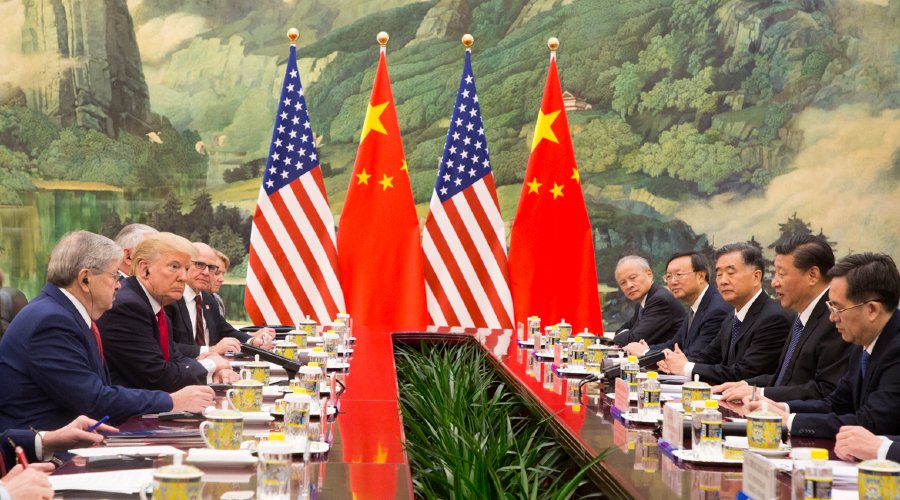How the United States Can Cooperate While Competing With China
The tensions between the United States and China aren't going anywhere, but there is still room to work together.

Published by The Lawfare Institute
in Cooperation With

Editor’s Note: The debate over U.S. policy toward China often ends up as a caricature, with the choice being a false dichotomy between confronting China or befriending it. Under all recent U.S. presidents, including President Trump, the answer lies between these extremes. Jacob Stokes of the United States Institute of Peace offers guidelines to navigate this in-between space, laying out rules for cooperating with China even in an overall context of competition.
Daniel Byman
***
One of the most virulent attributes of the novel coronavirus has been the timing of its emergence. The pandemic, a quintessential transnational problem requiring coordinated global action, appeared just as the prospects for cooperation between the world’s two leading superpowers, the United States and China, hit their lowest point in nearly five decades. In another time, the United States and China could have worked together to rally the world to combat this once-in-a-century challenge—by, for example, jointly containing the spread, ramping up production of medical equipment and pharmaceuticals, developing therapeutics and a vaccine, rescuing the world economy, and cushioning the societal impacts. Instead, Washington and Beijing seem to be more at odds every day. The pandemic is further inflaming their underlying “strategic competition” and creating new rifts between the two countries instead of illustrating the value of cooperation.
That’s a tragedy in this time of crisis. Geopolitical jockeying should not stop the United States and China from seeking pragmatic ways to cooperate. America and the Soviet Union cooperated during the Cold War on environmental, arms control, and scientific issues, demonstrating that even archrivals can find common pursuits. The process of developing and implementing a cooperative agenda with Beijing has pitfalls, though. Working together does not always serve U.S. interests or advance American values. Here are five guidelines for how the United States can be smart when seeking collaboration with China, not just on global health issues but across the entire relationship. These principles address how to cooperate as much as which issues to cooperate on.
1. Build coalitions that include like-minded states and multilateral organizations, and then try cooperating with China. American leaders should view eliciting cooperation from China as a team effort, not a bilateral endeavor between Washington and Beijing. The old adage holds true in world politics as elsewhere: There is strength in numbers. Consider, for example, the prospects for cooperation with China when the United States leads a group that includes allies and partners instead of acting on its own. Enlisting regional and global institutions in those campaigns can also help shape China’s incentives. This remains true despite the fact that the current patchwork of global governance groupings is aging and under strain.
Building coalitions is harder, but the results are worth the effort. One of the central insights from negotiation theory is that developing fallback options—experts use the term “best alternative to a negotiated agreement,” or BATNA—provides a source of leverage. The party sitting across the table is more likely to agree to favorable terms if you have other good options. Building an international coalition around key topics means China will face a choice: join a large and diverse group, or be the odd country out. The fact that Beijing is trying to do the reverse of Washington illustrates the value of this guideline.
2. Refuse to trade concessions in Asia for cooperation on global issues. At times, U.S. policy toward China has effectively—although never explicitly or intentionally—traded cooperation on global issues such as climate change and countering Iran’s nuclear program for more permissive policies toward Chinese assertiveness in the Indo-Pacific region. Beijing’s island building in the South China Sea is an especially vexing example. China’s desire to frame choices in this way is natural. Rising great powers often try to strike a bargain with the world wherein they will adhere to global standards in exchange for control over what happens in their neighborhood. But Washington should not make that deal with Beijing.
Furthermore, U.S. policy, rather than trying to confront China everywhere, should be less wary of Chinese involvement in areas that are peripheral to American strategic priorities. Generally speaking, that means Central Asia, landlocked South Asia, parts of the Middle East, and Africa. Chinese General Secretary Xi Jinping aims to expand China’s role globally through his Belt and Road Initiative, which proposes to boost Beijing’s influence by expanding infrastructure and trade. Looking at the initiative map, Beijing’s involvement is usually less detrimental to U.S. interests along the land-based Belt than the maritime Road. Washington has historically placed a higher strategic value on the rich, industrialized areas of Europe and East Asia, as well as the global commons of the high seas. Those areas anchor the U.S. forward defense strategy and prevent adversaries from acquiring a material advantage sufficient to threaten the continental United States and, therefore, are critical to American strategy in ways the other areas are not. The United States should construct the agenda for cooperation accordingly. To be sure, both superpowers can potentially cooperate in Asia on issues like Afghanistan and disaster relief, but it will be more difficult given that the region is the locus of their strategic competition. Other issues are more conducive to joint efforts, such as environmental coordination and financial stability.
3. Focus on the specific substance of cooperation rather than the process or label. American leaders have occasionally taken what might be called a “Field of Dreams” approach to getting China to cooperate: Build it and they will come. The idea was that setting up forums and processes to encourage working collaboratively would lead to convergence on the substance. The bilateral Strategic and Economic Dialogue with China during the Obama years, which built on an earlier version from the George W. Bush administration, operated on this premise. During the Trump administration, those talks have been restructured, canceled and set to restart again as part of the Phase One trade deal. Veterans of those meetings will usually be the first to say the process often eclipsed the substance. The end result was mostly frustration on both sides and only token progress.
Both sides have also tried to capture the bilateral relationship in a label that would encourage cooperation, using taglines like “strategic partner” and “responsible stakeholder.” Beijing has called for a “new type of great power relations.” But labels themselves do not solve the thorny problems involved in building cooperation with China, even if they do signal a desire to work together. And when relations hit a snag, critics often call for switching to more confrontational labels, which have the opposite effect of seemingly precluding cooperation. A better approach would forgo trying to attach a bumper-sticker moniker to the relationship and, instead, focus on developing a cooperative agenda from the bottom up based on specific overlapping interests.
4. Learn how the Chinese negotiate in order to recognize common gambits, while eschewing attempts to manipulate internal politics. Chinese negotiators consistently draw from a toolkit of established negotiating tactics to gain the upper hand with foreign interlocutors. These include declarations of the need for Beijing to maintain “face,” warnings not to “hurt the feelings” of all Chinese people, and dividing officials into “friends” and “enemies” of China. Most of these gambits rely on perpetuating what many would (rightly) consider to be cultural tropes or essentialism. But experienced negotiators say they are China’s go-to ploys anyway. For Beijing, it is apparently a small price to pay to extract valuable leverage.
American officials should not buy into the need for Chinese leaders to receive special concessions for cultural reasons. Obviously, no politician from any country likes to look weak or appear to have made unnecessary concessions. Standard diplomatic decorum remains essential. But U.S. negotiators should not make special dispensations in service of meeting perceived unique constraints Beijing faces. Instead, the onus should fall to Chinese negotiators to resolve the contradiction between, on the one hand, having the power of an authoritarian system that can move society at the drop of a hat and, on the other hand, needing to carefully tend to public perceptions at every turn. The one exception to this guideline comes when U.S. policymakers can offer Beijing symbolic measures to provide face in exchange for substantive concessions.
Relatedly, the black box of Chinese internal politics is simply too complex and opaque to be a helpful factor in shaping U.S. policy. Even the best foreign experts on China know too little about the process of elite decision-making in the Chinese leadership compound of Zhongnanhai to be able to empower preferred factions or undermine hardliners. U.S. leaders should not pretend to know more than they do. It is not up to Washington to empower Beijing’s relative moderates, and it is unlikely American policymakers would be successful if they tried. This does not mean the U.S. side should make no attempts to understand Chinese politics. But Americans should be deeply humble about their ability to influence the system with any precision or insight.
5. Pursue humane policies but recognize that few issues completely transcend geopolitics. The coronavirus outbreak underscores that some threats simply demand cooperation on behalf of humanity generally. Pandemics fall into that category, as does dealing with climate change. Unfortunately, though, even seemingly universal issues can sometimes be leveraged for geopolitical ends. Washington should avoid the temptation to do so. Skeptics of this idea should remember that U.S.-China competition is, on some level, a worldwide contest for hearts and minds. Advantages will accrue to the country seen by others as adopting an agenda that benefits the whole world, in addition to the value of aiding humanity for its own sake.
At the same time, U.S. policymakers should be on guard against Chinese policies that take advantage of cooperation for their own purposes. For example, Beijing’s repression of Uighurs and other ethnic minorities in Xinjiang province—carried out under the guise of stamping out terrorist groups—precludes adding countering terrorism to the list of default cooperative issues. China has also weaponized technical bodies like the World Health Organization and the International Civil Aviation Organization to isolate Taiwan, and found ways to leverage peacekeeping and disaster relief campaigns for its own ends.
To be clear, China has acted responsibly on issues in the past and will likely continue aspects of that approach in the future. Beijing does not necessarily want to tear up every aspect of the rules-based international order. But U.S. policymakers need to be prepared to revise plans in cases where China decides to cravenly exploit common challenges. America should not cling to the shreds of an outdated policy for the sake of maintaining the facade of cooperation.
Relations between Washington and Beijing continue to worsen, despite the coronavirus cataclysm, the recent Phase One trade agreement, and a seemingly positive rapport between Trump and Xi. Carving out some pragmatic areas of cooperation can help put a floor under the deterioration—and advance U.S. interests in the process. These guidelines can help U.S. policymakers get it right.





